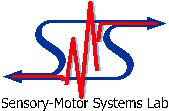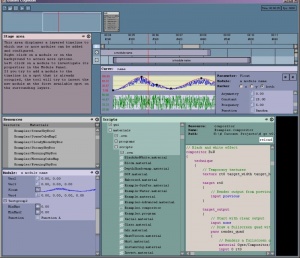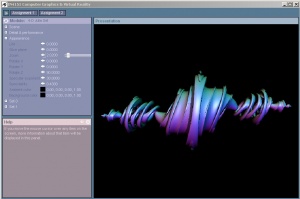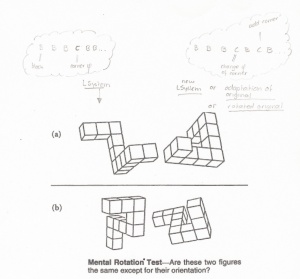Difference between revisions of "Assessment and rehabilitation of cognitive skills using virtual reality"
| Line 1: | Line 1: | ||
| + | == Introduction == | ||
| + | This is the homepage of the masters thesis project of Sacha Panic. The thesis focuses on the assessment and rehabilitation of cognitive skills, by using an augmented reality and affect adaptive game based training environment. | ||
| − | + | {| border="0" style="width:100%;" border="1" | |
| − | {| border="0" | ||
[[Image:panics_logo_eth.jpg|left|thumb|This thesis includes project work done at ETH Zurich]] | [[Image:panics_logo_eth.jpg|left|thumb|This thesis includes project work done at ETH Zurich]] | ||
[[Image:panics_logo_sms.jpg|left|thumb|Prof. Riener's lab, head of the Cognimat project]] | [[Image:panics_logo_sms.jpg|left|thumb|Prof. Riener's lab, head of the Cognimat project]] | ||
[[Image:panics_logo_idea.gif|left|thumb|The IDEA league provided financial support for my stay abroad]] | [[Image:panics_logo_idea.gif|left|thumb|The IDEA league provided financial support for my stay abroad]] | ||
|} | |} | ||
| − | |||
| − | |||
| − | |||
== Thesis position == | == Thesis position == | ||
Revision as of 09:54, 27 November 2009
Contents
Introduction
This is the homepage of the masters thesis project of Sacha Panic. The thesis focuses on the assessment and rehabilitation of cognitive skills, by using an augmented reality and affect adaptive game based training environment.
Thesis position
The thesis position can be summarized as follows:
- Neurocognitive rehabilitation is possible to a higher extent than previously assumed, which can be explained by constructs such as brain plasticity and cognitive reserve.
- Therapeutic exercises can be made more motivating for the patient, by using game design criteria from affective gaming.
- Due to the aging population, in the near future more people will need cognitive (re)habilitation than have access to, or can be treated in the existing clinics. Telerehabilitation can be used to provide therapy while the patients are situated in their home environments. In this way a larger part of the (patient) population can be rehabilitated, starting prior to or during the preclinical stages of their disease.
- Human factors play a significant and undervalued role when designing technology. Technology and the related interaction mechanisms should be designed to allow natural and embodied interaction as much as possible, to reduce the chance that it will be rejected by that part of the targeted population that is not very technologically savvy.
Short introduction
Although not widely used yet, virtual reality (VR) has been shown to have useful applications in health care. For example, the Delft University of Technology and the University of Amsterdam have successfully used VR to treat phobias as part of their joint VRET project. The assessment and rehabilitation of cognitive skills is another area where VR shows potential. Some cognitive impairments appear to be shared among conditions such as Alzheimer’s and Parkinson’s disease, or dementia.I have developed a thesis and research proposal which would investigate this use of VR. The research would be partially conducted at the Sensory Motor Systems Lab at the ETH in Zurich in coordination with the head of the lab, Prof. Riener. The Sensory Motor Systems Lab has experience in using VR in clinical rehabilitation, and this cooperation would allow me to conduct a clinical trial as part of my master's thesis work.
The research is centered around the creation of a virtual environment which can be used in the clinical assessment of an Alzheimer's patient, as well as in support of the (tele)rehabilitation of the patient's cognitive skills.
The experiment is designed to find answers to the following research questions:
- Does the use of augmented reality based training influence the rate of learning and motivation on a commonly used instrument of cognitive performance, when compared to a standard computer based training?
- Does the use of affect-adaptive training influence the rate of learning and motivation on a commonly used instrument of cognitive performance, when compared to a standard computer based training and/or augmented reality based training?
- Does the use of human computer interaction devices which support more natural and embodied interaction lead to a higher rate of acceptance by the targeted population? More specifically, will the input and output devices that are used be acceptable to and usable by the entire targeted population?
The cognitive performance of the participants will be assessed using a standard instrument such as the mental rotation task, a visuo-spatial skill of which can degrade due to the typical aging process, neurodegenerative diseases and traumatic brain injury. The participants will be divided into three groups. All participants will be trained and assessed on their performance on the mental rotation task. The modes of training differ between the three groups: the control group will train using a standard computer based training of the mental rotation task, the second group will receive an augmented reality based version of the standard computer based training. The third and last group will be trained on the task using an affect-adaptive game. From all participants motivational feedback on the training round, as well as task performance during an assessment round, is recorded and statistically analyzed.
Project status
A draft version of the literature research is available for download from the next section on this page. From December 7th 2009 until March 31st 2010 I will be at the ETH in Zurich working on the project.
Downloads
Literature research: [1] A draft version of the literature research into the topics 'cognition and neurocognitive rehabilitation', 'virtual reality based neurocognitive rehabilitation' and 'affect, learning and games'
Intermediate project presentation: [2] These powerpoint slides were used during an intermediate presentation of the project and its progress so far. The presentation will be given at the ETH on December 7th, and has also been given in a lecture Man Machine Systems at the DUT (3mE). The powerpoint contains clickable links to introductory papers that were published on related topics, as well as additional (requested) background information (e.g. presentations on TED and Discovery channel about brain plasticity and cognitive reserve)
Technology preview
This project will be developed using open source software which helps with optimizing the workflow of creating VR and AR based applications. The virtual training and assessment environment will be presented to the user using a consumer grade computer attached to a TV screen, while input and tactile output is also possible using a WiiMote. The orientation and position of a user's head will also be tracked (first demonstrated in the infamous video of a student at Carnegie Mellon University [3]). This creates a novel setup in which any TV is transformed into a holographic surface, and can act as a catalyst for user motivation and engagement with any virtual environment that is presented.
<anyweb>http://www.youtube.com/v/qqDgQP7kAqw&hl=nl&fs=1</anyweb>





